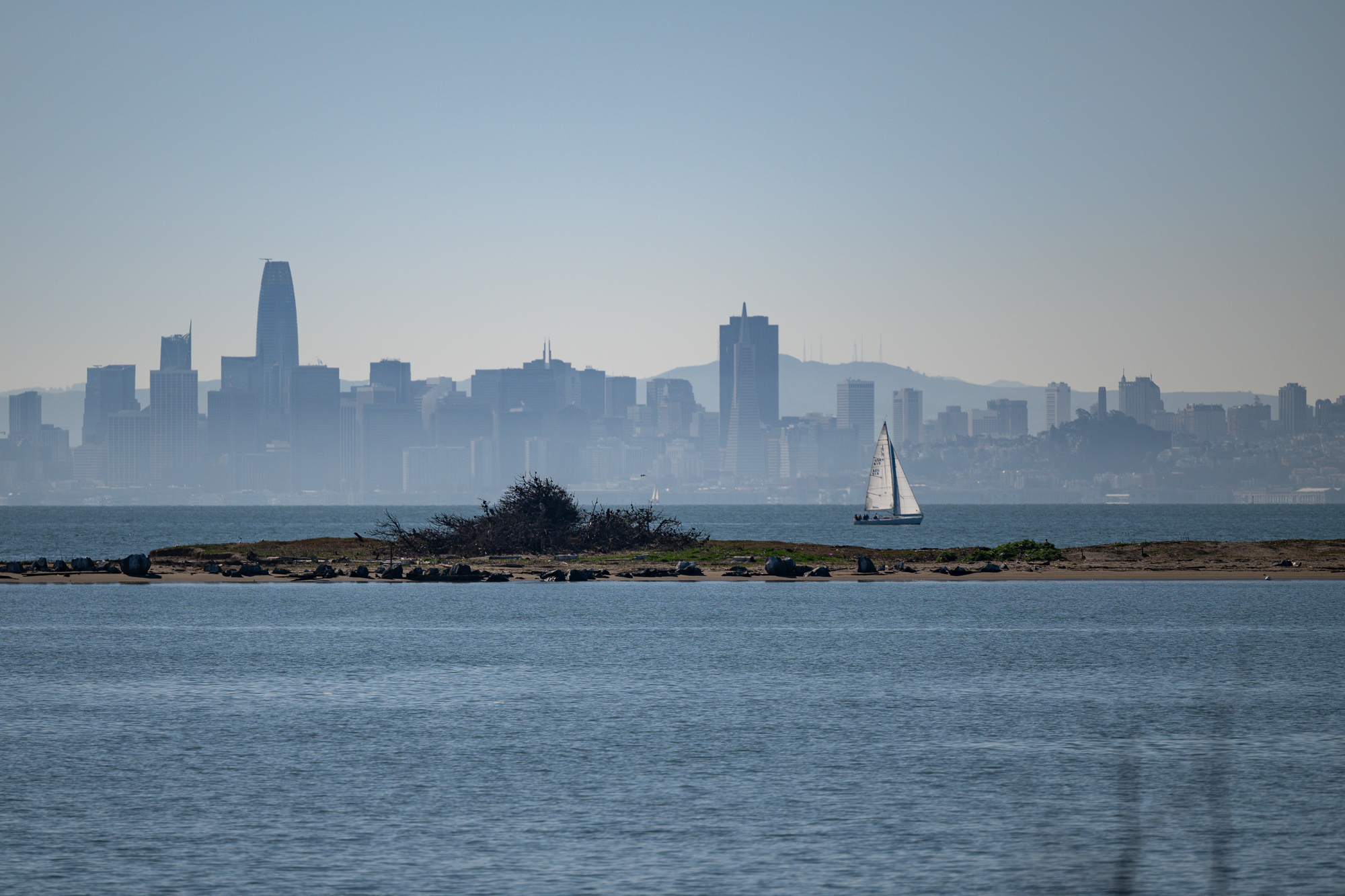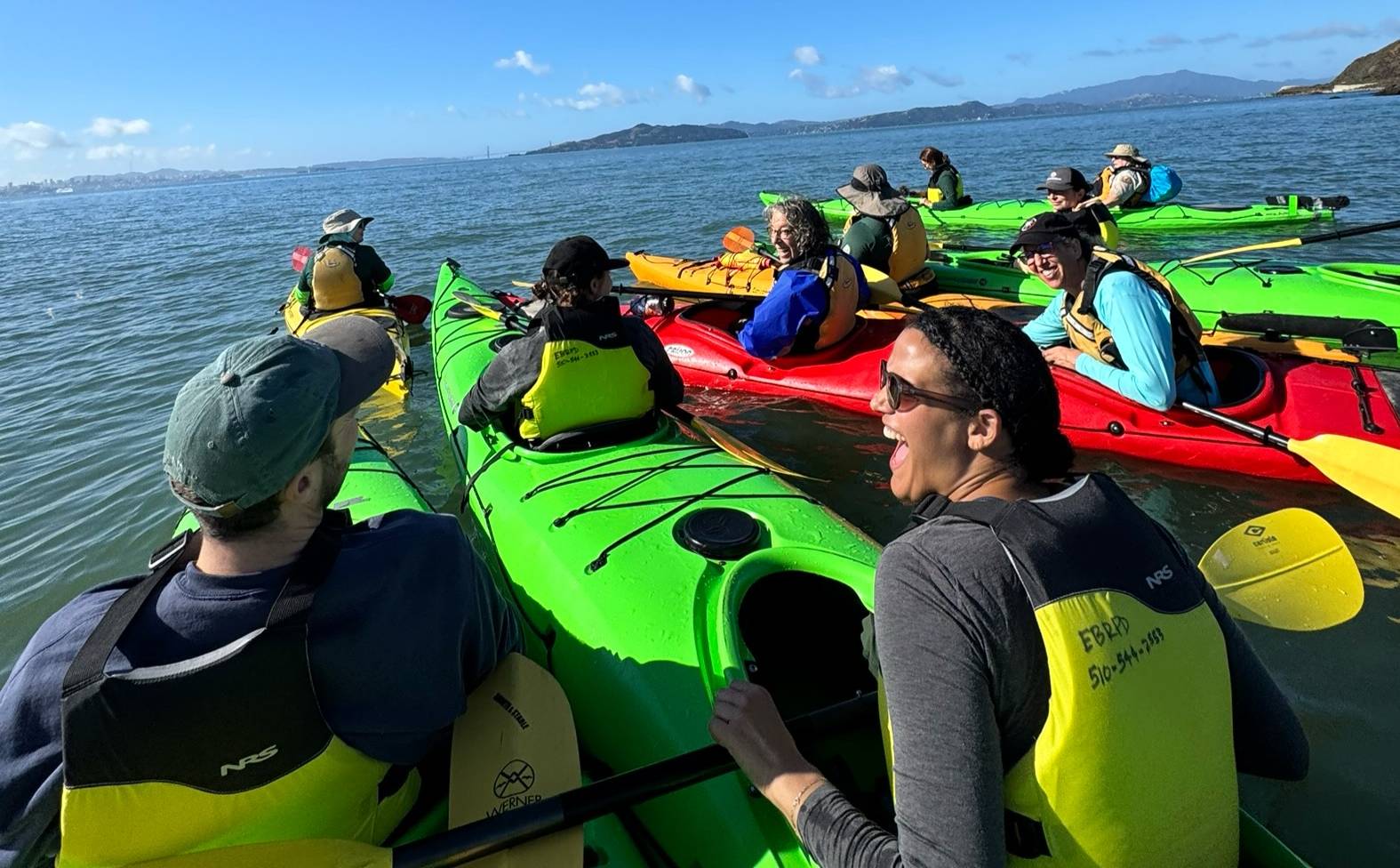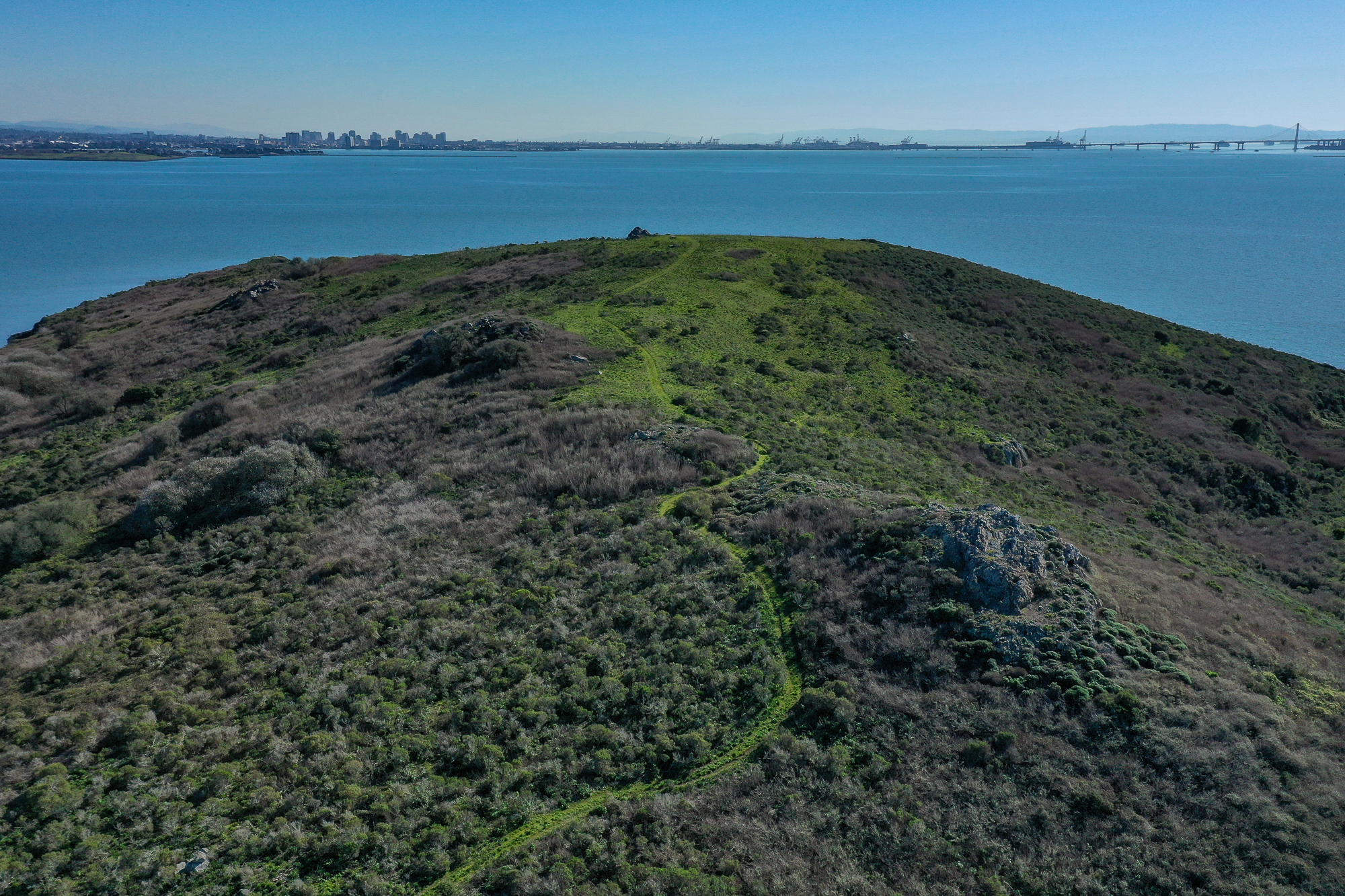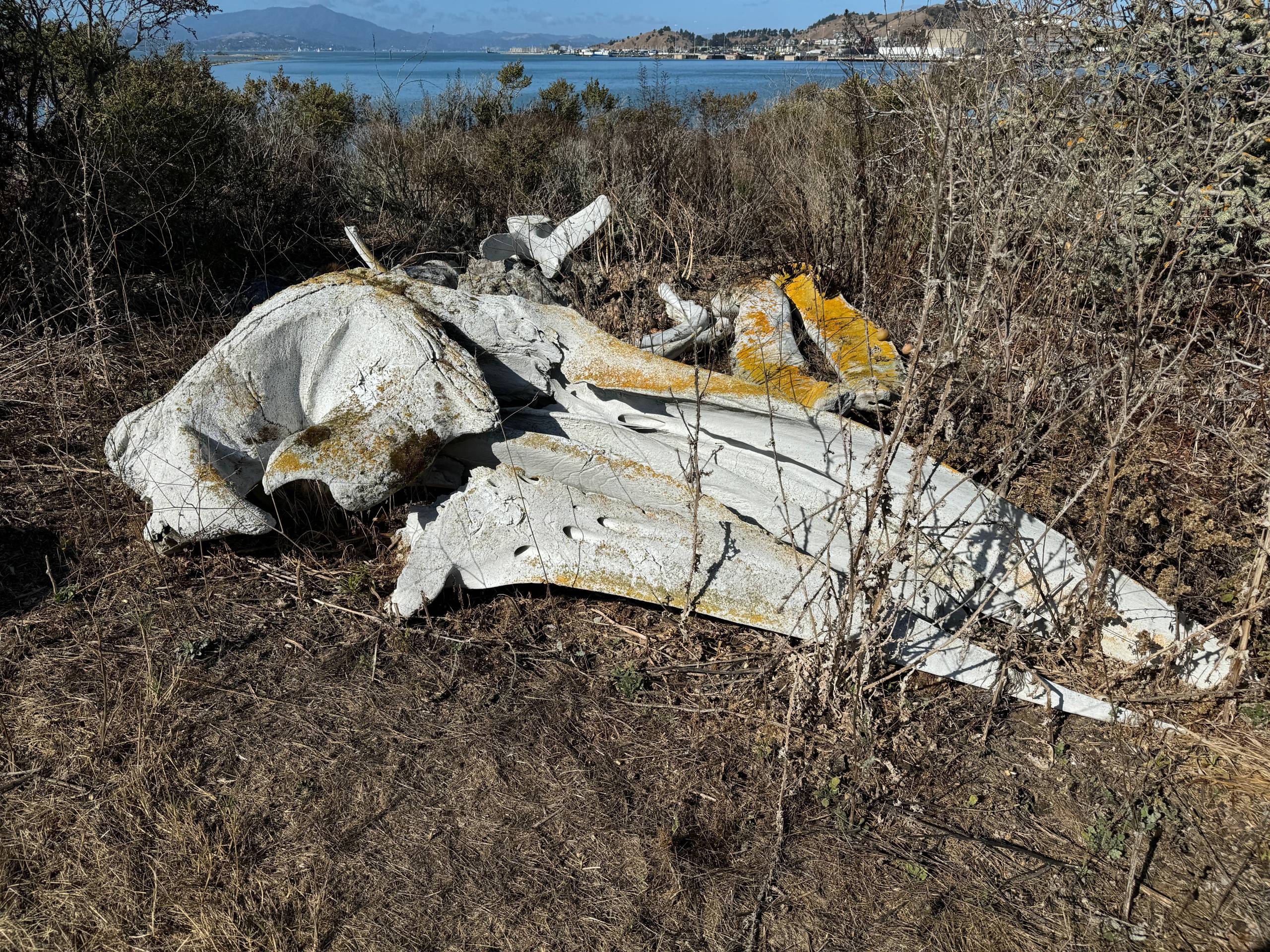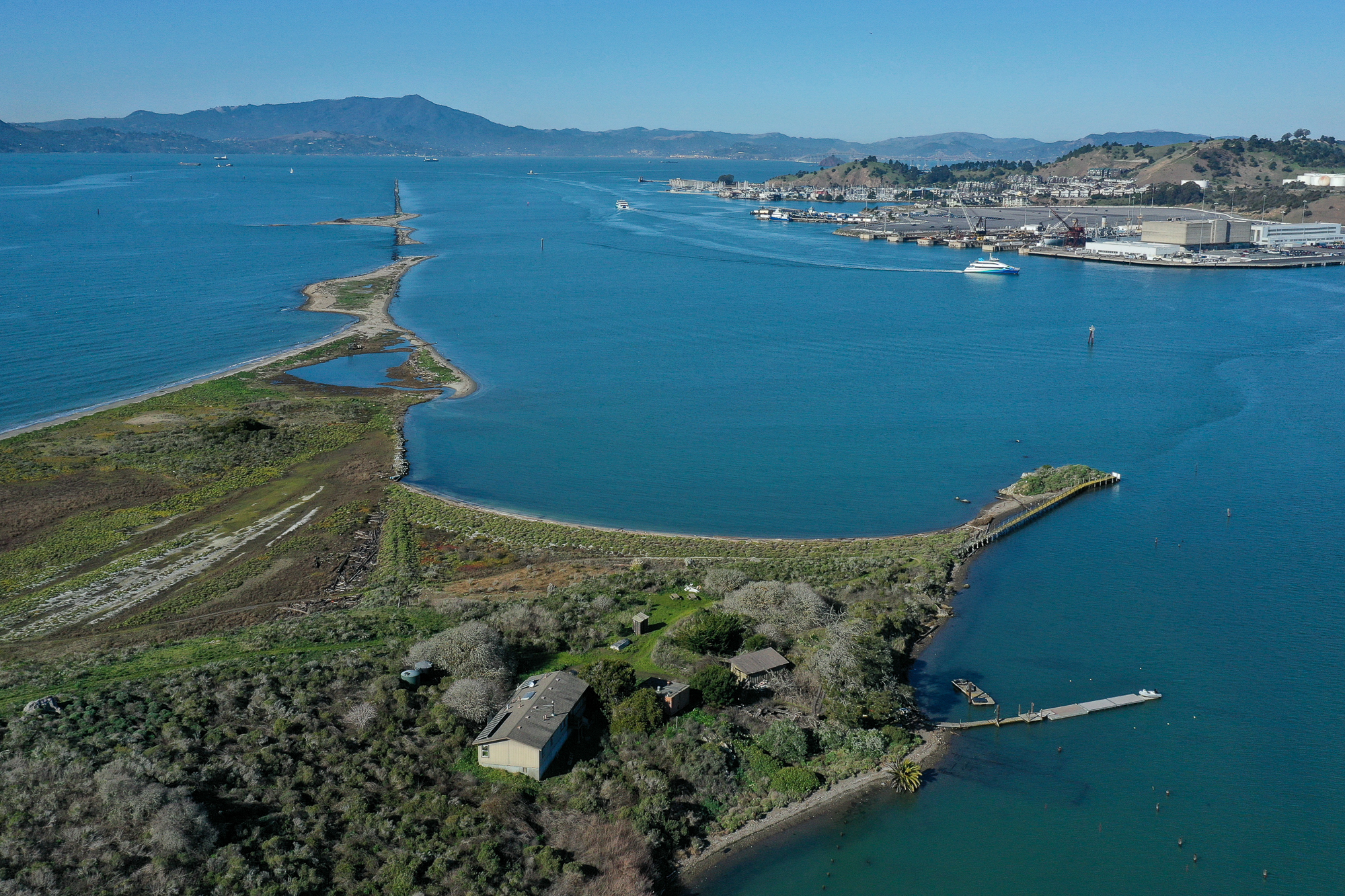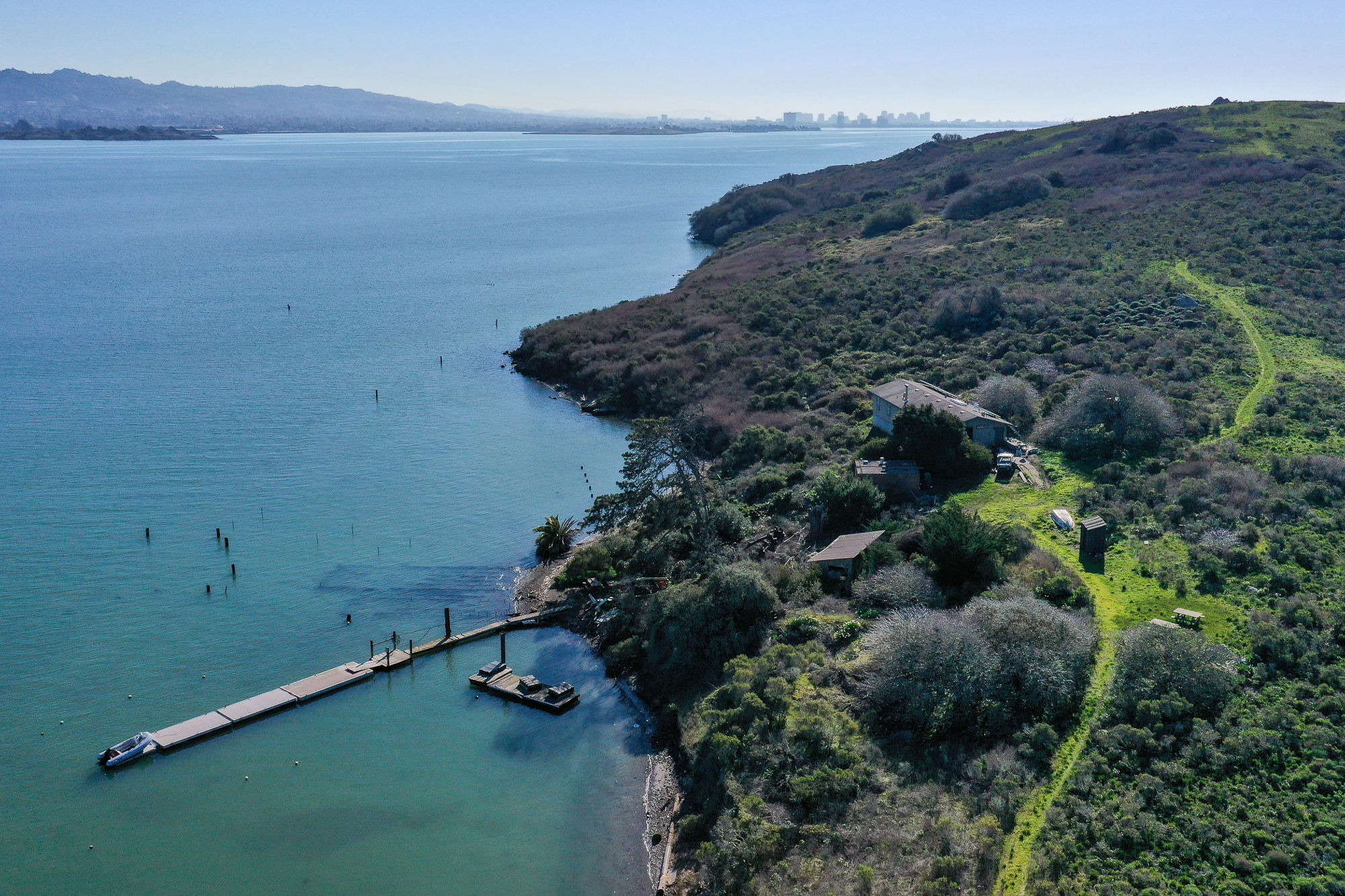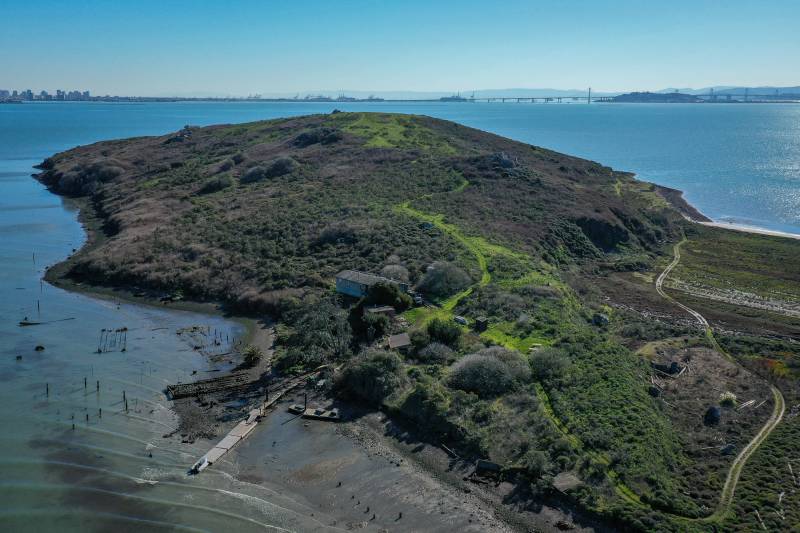Olivia Allen-Price: This is Bay Curious, the podcast that answers listener questions about the San Francisco Bay Area. I’m Olivia Allen-Price. Today we’ll find out about how this seemingly quiet little scrap of land has an active series of past lives. And we’ll meet the guy with one of the loneliest jobs in the Bay Area. Stick with us…
[Sponsor message]
Olivia Allen-Price: So, spoiler alert — you can paddle to Brooks Island. But it has to be on a guided tour with the East Bay Regional Parks District. The tours get canceled a lot due to bad weather, so it took a couple of tries for us to get out there. But finally, a calm, sunny day came along, and Bay Curious reporter Katherine Monahan put her microphone in a dry bag and climbed into a kayak.
[Sounds of paddling kayaks on the water “Yeah, it’s a little tippy right now. There you go.”]
Katherine Monahan: About 20 of us are launching out from the Richmond Marina towards this long, low island. It’s beautiful. Just a strip of grey and green against a fresh blue sky. After paddling about half a mile, we’re close to the shore where some wicked rotting pilings and bits of rebar are jutting out of the bay bottom.
[Paddling continues, “I see how it is. Oh!”]
Katherine Monahan: We steer carefully through them, into the narrow landing area, and climb onto Brooks Island.
[People walking on shore, birds chirping]
Katherine Monahan: Above us is a rectangular, tan-colored house — the one our question-asker David has spotted from shore. It’s the only home on the island, which has a population of one: caretaker Matthew Steven Allen. He says those pilings we just passed are dangerous.
Matthew Steven Allen: There’s a lot of debris in the water that’ll slice a boat open, slice your leg open, that you can run your boat into and then crash your boat.
Katherine Monahan: So, part of his job is to turn away kayakers who try to come on their own.
Matthew Steven Allen: COVID was bad. Every single group of people I talked to: “I just got this three days ago. I didn’t know.” Well, that’s why I’m here. My job is to make sure people are protected and safe and keep the island as rural as possible so that it stays the way it was 4,000 years ago.
Katherine Monahan: Allen likes it like that. He says he applied for this job with the East Bay Regional Parks District in 2011 after a motorcycle accident left him too injured to continue working as a mechanic.
Matthew Steven Allen: They came out and showed me the island and the house. And the only question they asked me was, uh, ‘Have we scared you off yet?’ And I said, nope.
Katherine Monahan: [Laughing] That sounds like a great job interview.
Matthew Steven Allen: Yeah
Katherine Monahan: He was told that the previous caretakers had had mental health issues — presumably made worse by the isolation.
Matthew Steven Allen: When I got the job, like everybody all the way up to the board members, “You’re doing great. Don’t go crazy,” Verbatim. “Don’t go crazy.” I’m like, OK.
Katherine Monahan: And so far so good. He lives out here with his pit bull Honey. He’s got well water and solar power and a compost toilet. He boats over to Richmond when it’s time for groceries, and he finds all kinds of strange objects on the shores.
To kick off our tour, naturalist Erin Blackwood with the East Bay Regional Parks District leads us to where Allen has laid out some of those curiosities — on a picnic table next to a big buckeye tree.
Erin Blackwood: Including this message in the bottle, which, who knows where this came from.
Katherine Monahan: She pulls out a mildewed sheet of paper and starts to read.
Erin Blackwood: [Reading letter] “To the seeker. Love is like a UFO traveling faster than the speed of light. Don’t hide in the shadows.”
Katherine Monahan: …OK. There’s also buoys on the table and bones.
Erin Blackwood: This is a harbor seal skull. This one, however, is a California sea lion skull, male.
Katherine Monahan: There’s the skull of a young deer — one of three that swam out to the island together a few years ago. Raccoons sometimes swim ashore, and there’s a resident population of voles — basically field mice — that escaped from a scientific study. And that’s about it for land mammals on the island.
But there are over a hundred different species of birds that come through. And while Blackwood talks, a swallowtail butterfly flutters down and lands on her.
Erin Blackwood: Oh, look at that iridescence on the back.
Katherine Monahan: …And then takes off.
Erin Blackwood: There she goes! Alright, we’ll follow her.
Katherine Monahan: We set off on the hike — a 2-mile loop to the top of the island and then down the other side and back around. It’s a narrow, rocky trail, and Blackwood points out the native plants around us.
Erin Blackwood: Oh, here’s a soap root. And there’s another buckeye.
Katherine Monahan: The indigenous Ohlone people used these plants while living here, at least seasonally, for thousands of years. Fishing, gathering shellfish, and hunting birds. The top, when we reach it, is about 160 feet above sea level.
Erin Blackwood: Oh man, another great view! Look at this.
Katherine Monahan: There are no trees up here, so you can see 360 degrees.
Erin Blackwood: Golden Gate Bridge, Angel Island, Marin Headlands…
Katherine Monahan: This island has had different names over the years. When the Spanish arrived in the 1700s, they called it Isla de Carmen. By 1850, it was called Brooks Island on the maps, but…
Erin Blackwood: I still haven’t found any information about why it was called Brooks Island. Who’s Brooks?
Katherine Monahan: And as we look out at Yerba Buena Island, Blackwell tells us about another old name — kind of a weird historical inside joke.
Erin Blackwood: In the 1800s, there were sheep on Yerba Buena Island and it was called Goat Island.
Katherine Monahan: Around then a Croatian man called Luccas Gargurevich settled here and raised 10 children with his wife.
Erin Blackwood: And he had goats on this island. What do you think he called this island? [“Sheep Island?”] Sheep Island. See?
[Music]
Erin Blackwood: OK, it’s a little steep right here, watch your step.
Katherine Monahan: We head down the other side, to where the trail levels out and runs along the south shore. And as we walk, we see, right next to us in the grass … an entire whale skeleton.
Erin Blackwood: This was from 2020. This is recent. Yeah. So it’s been, it’s been, it’s decayed, decayed quite well. Oh, there’s a little bit. You can see there’s a little bit of stuff on that rib right there.
Katherine Monahan: It’s over 30 feet long with a full chain of vertebrae.
[Sounds of people examining the skeleton, “These fissures are so beautiful.”]
Katherine Monahan: We find a piece of baleen — the whale’s equivalent of teeth — it looks kind of like a comb, but as big as your arm.
Erin Blackwood: Oh, there’s a little bit of baleen! Oh! Wow! [People ooh and ahh]
Katherine Monahan: Recreation coordinator Stuart Reed remembers when the whale first washed ashore.
Stuart Reed: The smell was just horrible. But when you paddled to the other side, you could, like, get a great view of it and not smell any of it because the wind was coming from your back. So every week I was like seeing it decay and it was just, like, really cool.
Katherine Monahan: Nowadays, that’s about as big as the action gets here on Brooks Island.
[Sound of waves crashing on the shore]
Katherine Monahan: That and the weird garbage that washes up. We head out on the rocky beach to take a look.
Katherine Monahan: What you got? [“Something gooey.”] Gooey? Yeah.
Tony Mistretta: Anything that floats will show up here. Yeah. Because there’s nobody here to pick it up. It just collects
Katherine Monahan: Recreation leader Tony Mistretta points at one of those playmate coolers — the ones with the rotating top. And as we amble down the beach we find a plastic triceratops … a needle … plenty of trash.
Tony Mistretta: Like normally, there would be people on the other shores, and they pick up, you know, like all the cool shells and all the cool stuff, or they’re doing a cleanup. But because there’s no one on the island, it just collects unless Matt’s picking it up.
Katherine Monahan: But Brooks Island wasn’t always this deserted and quiet. As we continue our loop, naturalist Erin Blackwell points out a massive crescent-shaped scar in the south face of the island. It’s an old rock quarry — mostly grown over now with coyote brush and fennel, but greywacke boulders are still scattered around.
Erin Blackwell: Looks like a lot of the quarried rocks were just like, left behind.
Katherine Monahan: In the late 1800s this was a major industrial operation. Workers blasted out stone and hauled it off to build San Francisco’s great seawall around the Embarcadero, and later the Carquinez Bridge and the Bay Bridge toll plaza and the Berkeley Marina.
Erin Blackwell: Also a part of San Quentin was used, uh, from this rock.
Katherine Monahan: There was also an oyster farm out here.
Erin Blackwell: They imported oysters from Washington State. So it was not the native oysters, it was the larger oysters that most people are familiar with eating.
Katherine Monahan: That lasted until the early 1900s when the bay got too dirty. And then the world wars began.
Erin Blackwell: There were plans to make this into a naval base. And so they were basically going to level the island.
The idea was to connect it to Point Isabel to make a battleship harbor. But the Navy chose Hunter’s Point instead. And then things took a recreational turn in the 1960s, when some famous people turned this island into a private bird hunting reserve.
[Bing Crosby’s “Mr. Meadowlark” plays: “I’m out in the country but I don’t know why. Cause I’m strictly a city-lovin’ guy. Just sittin’ there when a little bird flies my way…]
Katherine Monahan: Singer Bing Crosby was one of the members of the exclusive Sheep Island Gun Club. and so was Trader Vic — the self-proclaimed inventor of the mai tai. They kept a houseboat on the island, and they’d boat over from Richmond, release pheasants and other exotic birds, and shoot them.
Erin Blackwell: I don’t know, you might see some shotgun shells around, so keep your eye out.
Katherine Monahan: Blackwell shows us what looks kind of like a Boy Scouts fire ring, with an old barbecue grill, tucked behind one of Brooks Island’s freshwater ponds.
Erin Blackwell: They probably, you know, cooked them right up right there.
Katherine Monahan: And then Bing Crosby usually wanted to go get a drink at the Hotel Mac in Point Richmond around 2 p.m. Apparently, they tried to stock the island with deer as well, but the deer kept swimming back to shore.
[Bing Crosby’s “Mr. Meadowlark” plays: “(whistling) That’s where you come in. Mr. Meadowlark, now you should cop a gander when I’m kissing my chick”]
Katherine Monahan: The island’s current incarnation kicked off in 1968 when the East Bay Regional Parks District bought it, promising residents a new public park with swimming and boating and camping facilities. But the district kept leasing the island to the gun club for another 20 years. Finally, it bowed to public pressure and told the rich and famous hunters it was time to go.
Erin Blackwell: They were finally evicted in 1988.
Katherine Monahan: And in 1990, Brooks Island became a public park. By then, the parks district had changed the vision from recreation to conservation: The island would be a bird sanctuary and a place for native plants to thrive.
Which brings us to our final stop on the tour — a long sand spit that extends out from the northwest tip of the island. It’s a nesting site for the Caspian tern — a mostly white bird with a bright orange beak.
Erin Blackwell: These are birds that were eating a lot of salmon up in Oregon and Washington.
Katherine Monahan: So to protect the salmon, wildlife officials slowly chased off the terns.
Erin Blackwell: And then they eventually made their way here.
Katherine Monahan: Where they started eating the local salmon. But they still enjoy some protection. Matthew Steven Allen, the caretaker, says the tip of the spit is the one part of the island where people are allowed to come ashore on their own. But only in the winter, when the Caspian terns aren’t nesting there. And even then, he says, it’s really not a good idea.
Matthew Steven Allen: The silt has no bottom. So if you get out of your boat and say the water line’s like a hundred feet away, that hundred foot of silt is quicksand and it’ll just take you, until your waist.
Katherine Monahan: As we reach the end of our tour and paddle back toward the mainland, we pass a flock of pelicans and a seal. And it feels right that Brooks Island stays pretty untouched by humans.
Matthew Steven Allen: Everything is a little different, and it’s just a little special, and so I like, I like protecting it. So I’ll be there for a while.
[Sounds of water flowing, gentle music]
Olivia Allen-Price: That story was reported by KQED’s Katherine Monahan.
If you want to take a boat or kayak tour out to Brooks Island, head to the Brooks Island page on the East Bay Parks website for details. We’ll put a link in our show notes too.
Our colleagues at The Bay are working on a podcast episode about dating in the Bay Area — the good, the bad, and everything in between — and we’d love to hear from you. What’s your experience been like? What’s dating like in your city? Do you have a wild story? Leave a voicemail at 415-710-9223, or send a voice memo to thebay@kqed.org. Tell them your name, your city, and your story.
David Stein: Bay Curious is made in San Francisco at member-supported KQED.
Olivia Allen-Price: Our show is produced by Amanda Font, Katrina Schwartz, Christopher Beale and me, Olivia Allen-Price.
Extra Support From Jen Chien, Katie Sprenger, Maha Senad, Holly Kernan, Alana Walker and everyone at Team KQED.
I’m Olivia Allen-Price. Have a great week.
